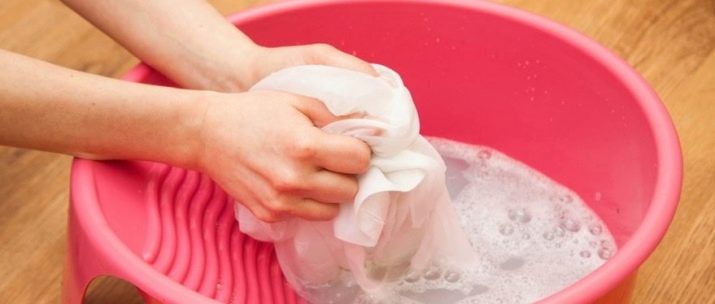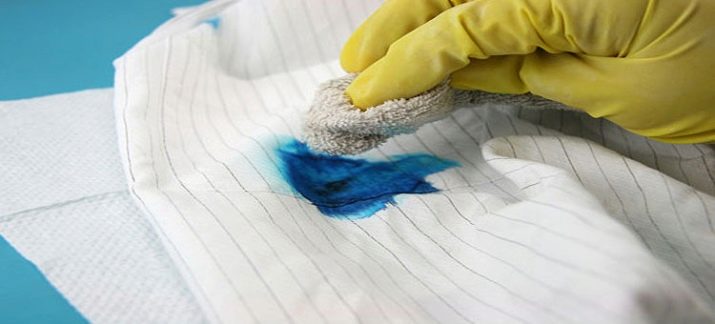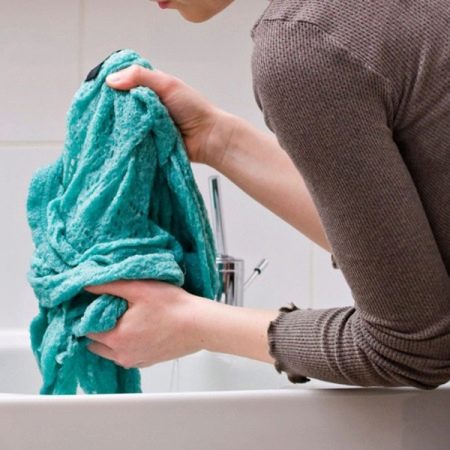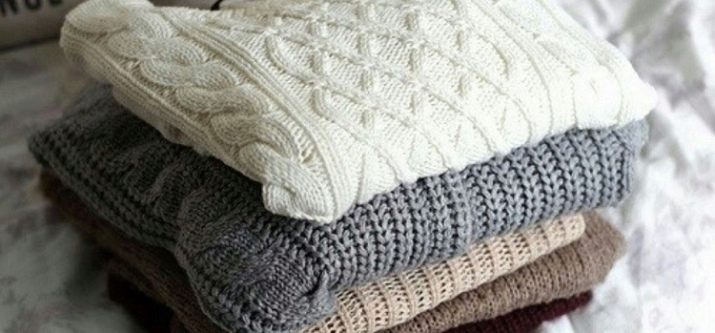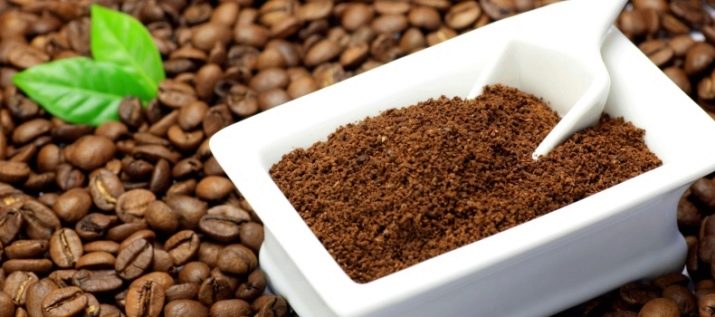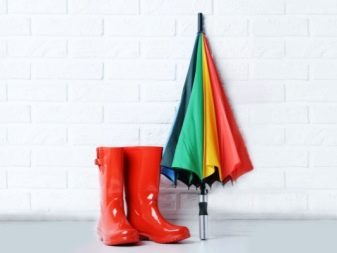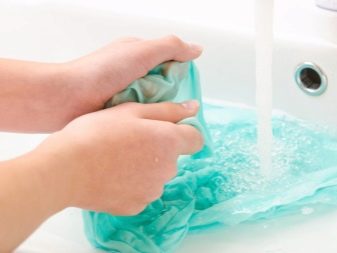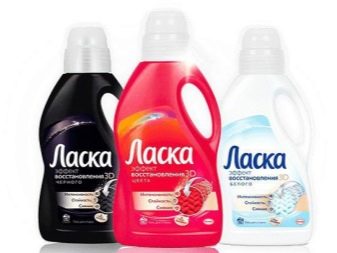How to wash by hand?
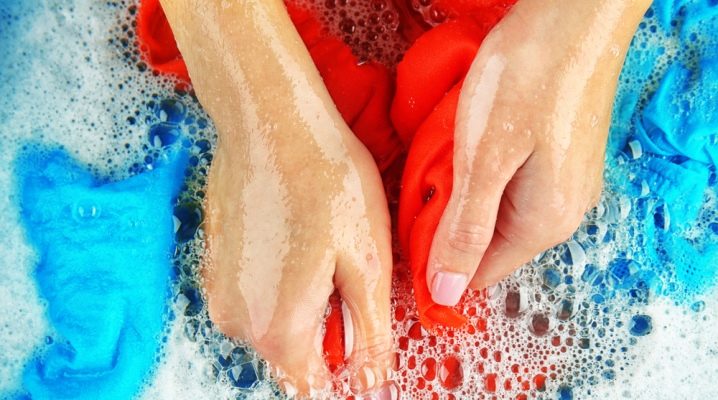
Modern housewives hardly know how to wash things by hand. This skill seems useless to them. However, the ability to wash things yourself must be owned. After all, the "mechanical assistant" may suddenly break, and some clothes require a delicate and careful washing, which even the most benign mode of the automatic machine sometimes cannot cope with.
Features
Hand washing is not as complicated as it may seem at first glance. It will only require soiled clothes, a basin, water of a certain temperature (depending on the nature of the fabric), detergent, rinse aid and rubber gloves. Perhaps the last item on the list will puzzle you, but the presence of gloves is essential to preserve the health and beauty of your hands. Chemicals mercilessly corrode the upper layer of the skin and reddening and cracks are formed on the hands.
It is advisable to place the basin in such a way that your back is not in constant tension. For this you need a stool or a board, which is securely fixed on the sides of the bath. Next, turn your attention to dirty laundry. Things of light colors should be washed first, as well as first washed less soiled clothes. Products with stubborn stains should be postponed until later and subjected to more thorough processing.
Typing in a basin of water, you must deal with the powder or detergent. Pour or pour into a container. Wait until it is completely dissolved. Undissolved powder can get stuck between the seams, as well as leave stains.
Then proceed to the soaking clothes. The dirtier the thing, the longer it will have to be soaked. If the laundry is not very dirty, then you need to soak it for 10 to 20 minutes. Try not to overdo the laundry in the basin, otherwise it will get an unpleasant smell.
The intensity of hand washing and spinning is largely dependent on the type of clothing and the fabrics from which it is made. Highly greasy places on products, such as collars and cuffs, are often prewired with soap.
The final stage will be rinsing. For him, you will need to change the water and rinse things two to three times. The creaking of the water on the fingers, in which the rinsing takes place, is a good sign. This means that the item is well rinsed.
Do not forget about clothes with special soiling, which are very difficult to display. Treat the stain on clothes with a special substance and set aside. If you find it difficult to determine the origin of the dirt, then use the universal stain remover manufacturer, which you prefer.
After the entire procedure, hang the clothes to dry, shaking each item before it. Thus, ironing clothes will be much easier and faster.
Washing hands
To properly perform the washing by hand, you must select the correct water temperature. Most often, it is indicated on the textile tag. If the tag is trimmed, then in this case you will have to be guided by the nature of the material.
Products made of cotton and flax can be washed at any degree, as they without any consequences tolerate hand washing and do not shrink. But if you had to wash large items of natural fabric, it is best to soak them in warm rather than hot water.
Natural silk and wool are preferably washed at a temperature of 30-40 ° C. Squeezing such clothes is not necessary. Let her drain. For items made from viscose, cool water up to 30 ° C will do. Synthetics should be washed at a water temperature of 40-50 ° C.Combined materials (cotton + nylon, wool + lavsan) are washed at a water temperature of 45-50 ° C.
Another important feature is the choice of detergent. This can be a powder, washing gel, laundry soap or bleach chloride. It all depends on your preferences. Here are a few tips for choosing:
- Handwash powders have less of a detrimental effect on the skin of the hands and are considered standard in use.
- Washing gel is also widely used by housewives. Perfect for products intended for washing at low water temperatures. It dissolves quickly, but they act less effectively in cool water. Thanks to this product, you can easily give up any pollution. The disadvantage of this tool is the high price.
- If you have an allergy to household chemicals, then the laundry solution will be a saving solution. It does not harm the skin at all and perfectly copes with stains on clothes of any kind.
- For washing products from fabrics of natural origin white, you can use bleach chloride. This tool will not only brilliantly do its job, but also relieve clothing from dullness.
- Oxygen bleach attracts the attention of most because it can cope with even the most serious pollution. However, such a weapon against stains is very detrimental to the skin. Therefore, it is better to refer to this solution in the most extreme cases.
- Air conditioning is rarely used as an independent detergent. Most often it is used together with a powder in order to give the clothes softness and aroma.
clothing
Before we reveal the secrets of washing clothes, let's see what things fall into the list of unsuitable for washing in a washing machine. These include:
- silk products;
- cashmere;
- Underwear;
- men's wool sweaters;
- gentle blouses;
- lace products;
- clothes covered with unstable paint.
Also in the machine, it is undesirable to wash shirts, trousers, sweaters and T-shirts that can sit down.
Underwear is changed every day, so it is better to immediately disassemble the nuances of washing such products. It is undesirable to wash clothes in too hot water. If the thing is lacy, do not even think about rubbing it and turning it out. Cotton linen can be soaked before washing in water, diluted with vinegar. The use of bleach is also not recommended. To facilitate the washing will help a special solution, which is a spoonful of soda in three liters of water.
Particular attention should be paid to things made of wool. With inadequate care such products can significantly deform and stretch. It is better not to erase such things if there are no noticeable, clearly distinguished stains on them. But if wet cleaning cannot be avoided, then follow these rules:
- before washing, turn things on the wrong side;
- use liquid detergent. It dissolves faster and is rinsed out;
- water should not be above 35 ° C;
- rinse the coat thoroughly;
- stock up with water, as washing wool will require a lot of liquid;
- if the contamination is very deep, then in no case do not use bleach chloride, it is better to use acetic solution;
- You can also buy a special stain remover for wool;
- use a towel when spinning.
If you do not follow strict drying rules, the wool product can stretch. Do not squeeze the thing to the end. Leave it in an empty basin, so that all the glass is out of it. Shake well and flatten the clothes after washing. Dry the item horizontally on another cloth, which is a towel or sheet. Periodically turn the item and the fabric under it. If the temperature in the house is too low, use a hairdryer to dry it faster.
Do not forget that with the careful care of your favorite wool sweater, shawl and other things you guarantee durability and durability of clothing.
Footwear
Before proceeding with the removal of dirt on shoes, it is necessary to determine the structure of the material of the product, its resistance to detergents, the strength of compounds, etc. Most often, shoes that can be washed by hand include:
- slippers;
- sneakers;
- ballet shoes;
- sneakers;
- moccasins.
But there are also products that are not desirable to wash. These are shoes:
- leather;
- varnished;
- suede;
- fur;
- from sheepskin.
If your product is not in the last list, feel free to proceed to action. To begin, clean the upper part of the shoe from adhering dirt with a brush. If the surface of the product is gentle, then pre-moisten the dirt. Use running water to remove dirt from the sole. Using a match, remove small stones from the tread. If chewing gum is stuck to the sole - wind the shoe in polyethylene and send it in the freezer. After three or four hours, you can easily get rid of the stuck trouble, just poking it with a knife.
Do not be afraid to use effective stain removers. Do not forget the insoles and laces, if any. When washing and rubbing itself, use liquid detergents that quickly dissolve in water.
Accessories
No matter what accessory you are going to wash, you will need:
- wash;
- washing powder or stain remover;
- sponge;
- brush;
- ammonia;
- vinegar;
- lemon juice;
- alcohol;
- ground coffee or black tea (if the product is black).
Umbrellas that often help us out in rainy weather often fall under the category of accessories. To clear this useful attribute, you need to:
- pour in a deep basin of warm water;
- pour powder into a container with water and wait for it to dissolve (you can also use a concentrate for cleaning dishes);
- put in the resulting solution open umbrella for 30 minutes;
- then carefully wipe the surface with a brush;
- rinse the product under running water or shower;
- shake off any remaining liquid;
- hang in a well ventilated area.
Not suitable for machine washable and nylon pantyhose and white handbags. If the item is made of thick, coarse material, then moisten a small piece of cloth in a concentrated detergent solution before cleaning. Then gently wipe with a rag greasy and overly contaminated places. When the accessory dries, proceed to smearing it with a colorless shoe cream, and after 40 minutes polish it.
At home, you can manually wash even a blanket or blanket. To do this, you must first soak textiles. It is advisable not to squeeze such things, and let them drain yourself.
Observing all the above nuances, you will be able to cope with the washing of any textile product.
Special attention to color
The principle of sorting clothes by color is similar to sorting when machine washable. White linen is washed separately from the multi-colored. Bright clothing is also sorted by color — for example, black to black, yellow to yellow. Things that require a delicate wash, it is also recommended to put in a separate basket.
If in your wardrobe there is a new thing that you have never washed, then be sure to put it in a separate basin.
Tips for all occasions
Hostesses need to consider the following points:
- If you are in the hands of a product made of fine cotton fabric that needs to be washed by hand, then use water at a temperature of 40-65 ° C.
- Means for washing, not requiring additional use of rinse aid, is considered a universal product "Weasel".
- For washing products made of wool perfectly suitable detergent called "Lanolin". It contains natural oil that is secreted by the skin of sheep to protect their wool. Thanks to this tool, your item will remain soft and will not be damaged.This substance can be found both in hardware stores and on Internet sites.
- If there are no special detergents in your home, then ask for help from a shelf with baby shampoo and liquid soap. These products of household chemicals are also suitable for delicate cleaning of things.
- If the dirt from the clothes does not come off, you can refer to the auxiliary attributes for washing. Brushes with soft and hard bristles can easily remove deeply absorbed stains.
- Clothespins are useful when hanging clothes.
- If your shoes have laces, then do not be afraid to wash them with other clothes. Of course, also observing the "rule of color."
- The old toothbrush will help to clean insoles of dirt. Lather the product thoroughly with laundry soap and rub on both sides with a brush.
To learn how to wash things by hand, see the following video.
